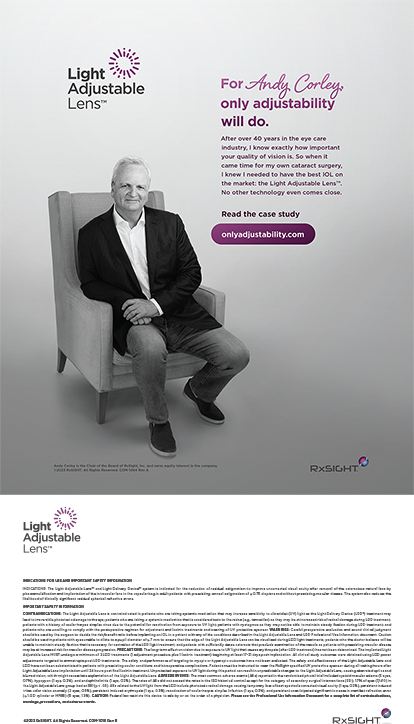
Diagnosis, treatment, and options are three of the most gratifying words that can be said to a patient who presents with an amorphous and recalcitrant ocular problem. For more years than we eye care providers would like to admit, patients who presented with signs and/or symptoms of dry eye disease (DED) could not get a distinct diagnosis and were treated with a random array of artificial tears, and other options were nonexistent.
Fortunately, the situation has changed. Effective therapeutic options for the treatment of DED such as Restasis (cyclosporine ophthalmic emulsion 0.05%; Allergan) are available, and others are in the pipeline. The frequency with which patients present with symptoms of DED as well as the need for an optimal ocular surface, such as prior to LASIK and premium IOL surgery, continues to grow in my practice and others’. Digital eye strain from the pervasive use of smartphones, the high rates of diabetes—which are associated with an increased rate of DED—and environmental issues such as air pollution are among the causes linked to the rise in DED.
GREAT STRIDES
DED represents a widespread and growing problem for the daily visual function of more than 30 million Americans, and it affects the outcomes of lenticular and laser vision surgery in thousands more. Recognition of DED as far more than a nuisance lit a fire under stakeholders in the ophthalmic community.1 Consequently, the past decade has brought great strides with respect to DED awareness, diagnosis, and treatment. The International Task Force guidelines proposed a classification of DED severity based on clinical signs and symptoms (levels 1-4) and developed treatment algorithms and recommendations based on symptoms such as discomfort, visual disturbances, corneal and conjunctival staining, meibomian gland dysfunction, tear breakup time, and Schirmer scores.2
DIAGNOSTIC MODALITIES
Since the guidelines were released, progress has come in the form of numerous diagnostic modalities designed to identify the type of DED afflicting patients. As the landscape of treatment options evolves, the importance of careful diagnosis is elevated. Once, we treated patients with whatever therapy was available regardless of the specific nature of their symptoms, because our options were limited. Now, we can identify specific nuances, and in the not-too-distant future, we will be able to offer targeted treatment. An expanding array of diagnostic tools plays a role in documenting the prevalence and type of DED (eg, lacrimal gland disease, mixed mechanism disease, meibomian gland dysfunction, and aqueous tear deficiency). Modalities such as tear osmolarity (TearLab), matrix metallopeptidase 9 detection (InflammaDry; Rapid Pathogen Screening), and LipiView and LipiView II (TearScience) with meibomian gland imaging and testing for Sjögren disease via early disease stage antibody detection (Sjö; Bausch + Lomb) are among the approaches available to help us plan our targeted treatment approaches.
Progress in the area of therapeutics is also being made, first with the approval and availability of cyclosporine and, now, with substantial research and development of numerous other options currently in the pipeline. Until cyclosporine became available, our options were mostly limited to short-term pulsed topical steroid therapy such as Lotemax (loteprednol 0.5% gel; Bausch + Lomb); advanced artificial tear formulations such as Refresh Optive Advanced (Allergan), Systane Balance (Alcon), and Soothe XP (Bausch + Lomb); and punctal plugs and autologous serum drops. Cyclosporine, which is a mainstay in my practice, is approved for patients whose tear production is presumed to be suppressed due to ocular inflammation associated with keratoconjunctivitis sicca (levels 3 and 4). We very well may need to diagnose this disease earlier; when cyclosporine is used sooner (levels 1 and 2), my patients seem to do better.
CHANGE ON THE HORIZON
In October 2015, Shire announced positive topline results from OPUS-3, a phase 3 efficacy and safety study of lifitegrast versus placebo. OPUS-3 met the primary endpoint of significantly improving patient-reported symptoms of DED from baseline to day 84 (P = .0007). Additionally, OPUS-3 met the secondary endpoints of symptom improvement from baseline to days 14 and 42 (P < .0001 for both endpoints). Shire plans to use these data as part of its resubmission of the company’s new drug application for lifitegrast for the treatment of the signs and symptoms of DED in the first quarter of 2016.
If approved, lifitegrast will be the first new treatment for DED since cyclosporine. Some suggest that AzaSite (azithromycin ophthalmic solution; Akorn) holds that title. The drug is approved solely for bacterial conjunctivitis, however, whereas the new drug application for lifitegrast specifically requests an indication for the treatment of DED.
COMPARING THE TWO THERAPIES
Comparisons of cyclosporine and lifitegrast are inevitable, and speculation regarding whether the new entrant into the marketplace will unseat the market leader is in full swing. I do not foresee this happening. I believe that the availability of other options will draw attention to the market and spur overall growth. Given the vast market for DED therapies, there should be more than enough demand to support the market share needs of these two pharmaceuticals (see More Than Enough to Go Around.)
Also, lifitegrast and cyclosporine have different mechanisms of action and are appropriate in distinct instances based on different diagnostic algorithms. Lifitegrast mimics lymphocyte function antigen-1. This process prevents the activation of intercellular adhesion molecule-1, which is expressed on the inflamed epithelial cell surface. DED-associated inflammation is typically mediated by T cells that feature increased expression of intracellular adhesion molecule-1. Lifitegrast essentially breaks the cycle of T cell-mediated inflammatory response on the ocular surface.
Cyclosporine acts as a selective inhibitor of interleukin-2 release during the activation of T cells and causes cell-mediated immune response suppression.3,4 Cyclosporine’s mechanism of action is based on its effects on subconjunctival and lacrimal gland inflammation, resulting in an increase in tear production and conjunctival goblet cell density in a significant number of patients with moderate to severe DED who received treatment.5,6
Lifitegrast has a 7.0 pH, which is similar to that of the natural tear film. Based on studies reported to date, the drug is potentially complementary to cyclosporine therapy. This opens up the possibility of a belt-and-suspenders approach to patients who could benefit from the combination of an anti-inflammatory and an immunosuppressive mechanism of action. It has been widely reported that lifitegrast acts fast, and some see this as a potential benefit over cyclosporine, because the latter is often described as having a delayed onset of action. Many of my DED patients experience early relief with cyclosporine; its reputation for a delayed onset of action is a vestigial artifact of the clinical studies upon which its approval was based. Until lifitegrast has long-term follow-up in clinical practice, I believe it is far too soon to determine whether or not it acts quickly in any, some, or all patients.
CONCLUSION
The evolution of DED treatment has taken us from near helplessness to finally having a therapeutic option that offers relief to a significant proportion of patients. I am hopeful that the next drug to make its way into the DED armamentarium can move treatment along its evolutionary pathway. Meanwhile, I will continue to use cyclosporine as my first-line treatment and consider it the gold standard in patients who were once hard to treat until long-term, real-world evidence suggests that I should alter my algorithm.
1. Dahl AA, Davis CP. Dry Eye Syndrome (Dry Eyes, Keratoconjunctivitis Sicca). Available at: www.medicinenet.com/dry_eyes/article.htm. Accessed September 19, 2014.
2. Behrens JJ, Doyle L, Stern L, et al. Dysfunctional tear syndrome: a Delphi approach to treatment recommendations. Cornea. 2006;25(8):900-907.
3. Noble S, Markham A. Cyclosporine: a review of the pharmacokinetic properties, clinical efficacy and tolerability of a microemulsion-based formulation (Neoral). Drugs. 1995;50(5):924-941.
4. Donnenfeld E, Pflugfelder SC. Topical ophthalmic cyclosporine: pharmacology and clinical uses. Surv Ophthalmol. 2009;54(3):321-338.
5. Sall K, Stevenson OD, Mundorf TK, Reis BL. Two multicenter randomized studies of the efficacy and safety of cyclosporine ophthalmic emulsion in moderate to severe dry eye disease. Ophthalmology. 2000;107(4):631-639.
6. Wilson SE, Perry HD. Long-term resolution of chronic dry eye symptoms and signs after topical cyclosporine treatment. Ophthalmology. 2007;114(1):76-79.
Karl G. Stonecipher, MD
• clinical associate professor of ophthalmology, University of North Carolina, Chapel Hill
• director of refractive surgery, TLC in Greensboro, North Carolina
• (336) 274-2244; stonenc@aol.com
• financial disclosure: consultant to Allergan


